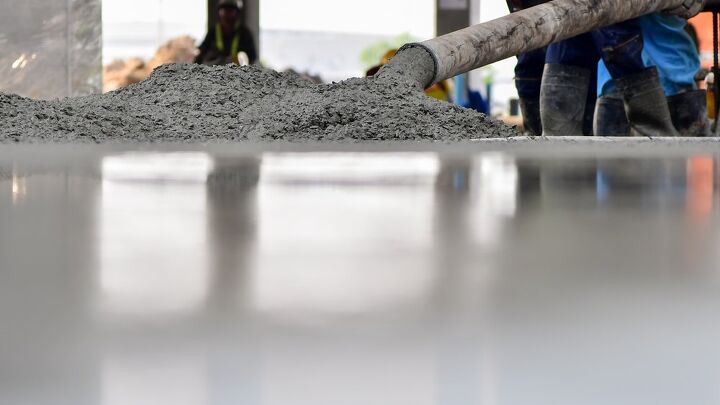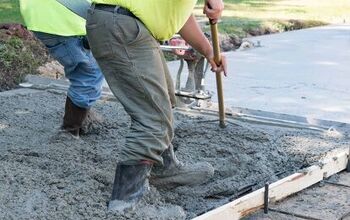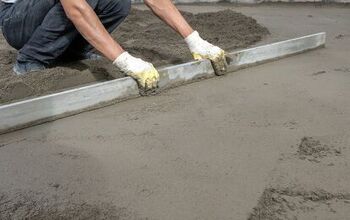Can You Pour Concrete Over Concrete?

Concrete has been used for thousands of years and it has evolved over that time. Builders and homeowners stick with concrete because of how reliable and durable it is. So, can you pour concrete over concrete?
You can pour concrete over concrete if it isn’t cracked and uneven. Patch and fill cracks in the existing concrete before you pour more or else the new layer won’t be as durable and even. It isn’t worth it to pour concrete over existing concrete if it is severely damaged because it won’t last long.
You can also pour a concrete slab on top of another slab, but the same rules apply. Contact a contractor or engineer to see if they think it’s worth it to pour a fresh layer of concrete. Follow along as we explore the important factors to consider before you pour concrete over concrete.
Can You Pour Concrete Over Broken Concrete?
You can pour concrete over broken concrete, but it’s not always worth it. The existing problems with your concrete will still be there when you pour more over it. That is why it’s important to treat cracks before you pour another layer of concrete.
It can be unsafe to pour new concrete over broken concrete in some cases. The location and condition of the concrete determine whether or not it can handle the extra weight. Concrete can weigh over 4,000 pounds per cubic yard, and its excessive weight could pose a structural risk.
For example, a broken and cracked concrete walkway could crumble underneath the weight of a fresh pour. You can also waste money when you pour over broken concrete because it may have a limited lifespan. The layer of damaged concrete will degrade and continue to break up and weaken the new concrete in some cases.
Can You Pour a Concrete Slab on top of Another Slab?
You can pour a concrete slab on top of another slab, but you need to exercise caution. Consider factors such as the condition, thickness, age, and location of the slab. Sure, a concrete slab can last for up to 100 years, but only if it is in good condition.
Pouring a concrete slab on top of another slab will add thousands of pounds of pressure. A severely damaged slab won’t likely be able to withstand the excess weight. The new concrete slab will also make your existing slab much taller which can be limiting.
This can become complicated if the slab is for a driveway, garage, or confined space. It is worth it to consult a structural engineer and contractor before you make your decision. However, it is common to add a new overlay to an existing slab as long as it is in good condition.
Minimum Concrete Thickness Over Existing Concrete
The minimum concrete thickness over existing concrete is between 1.5” and 2”. It’s a great idea to go the extra mile and pour the concrete 2” thick to get as much stability as possible. Many cautious builder-owners pour concrete as thick as 2.5” to play it safe.
You can pour 1.5” of concrete over existing concrete, but that is too thin in most cases. This is especially a bad idea if the existing concrete is damaged and uneven. It will be much harder to fill gaps and sit evenly if the concrete isn’t thick enough.
The thickness also depends on the application and where the concrete is located. You wouldn’t want concrete steps to become too thick, for example, so pouring new concrete isn’t always ideal. Determine whether or not the concrete will be too thick and high once it’s dried before you pour more. Otherwise, you may need to remove what’s there and replace it.
Can You Pour Concrete Over Concrete Driveway?
You can pour concrete over a concrete driveway if the driveway isn’t too damaged. Widespread crumbling and cracks will make it difficult to evenly pour concrete over the driveway. It can be complicated to pour concrete over a concrete driveway if it leads into a garage.
The extra height from the concrete will make the garage and driveway uneven with one another. This can be a problem if you already have a tall driveway or vehicle as is. You will add at least 2” of height to your driveway if you pour more concrete.
Some contractors will encourage you to remove and replace your driveway if it is in bad shape. It can cost up to $1,700 to remove your existing concrete driveway and another $3,000 to replace it. However, the cost may be necessary if your driveway is in bad shape, or if adding concrete would make it too tall.
Can You Pour Self-Leveling Concrete Over Concrete?
You can pour self-leveling concrete over concrete as a topper. Builders and owners use self-leveling concrete for everything from tile work to patching concrete. It is an affordable and practical alternative to standard concrete which can be difficult to apply.
Self-leveling concrete is more popular than ever because of how easy to use and convenient it is. You don’t need as much water as you would with traditional concrete which removes several steps. Luckily, self-leveling concrete is easy to manipulate before it dries which helps to keep it even.
However, self-leveling concrete isn’t necessarily quite as tough as traditional concrete. It works great as a topper, but you wouldn’t necessarily want to use it as a slab and base for a driveway or garage. Pour self-leveling concrete over concrete to even out the surface or patch cracks.
Can I Pour Concrete Over 2 Days?
It is inadvisable to pour concrete over 2 days instead of all at once. Concrete needs to set and bond within the first 30-45 minutes. This short period is critical to the strength, bond, and durability of the concrete.
You should always plan for your concrete to set and cure at the same time if it is in the same area. Otherwise, the concrete will be uneven, less durable, and potentially patchy in certain areas. Some professionals need to wait until 2-3 hours later to mix and pour more cement, however.
A 2-day stretch would be too long for the concrete to properly and evenly set. Concrete finishes setting at the 10-hour mark, so adding more a day later would throw off the curing process. That is why it’s ideal to hire a professional or go into the process prepared to mix and pour the concrete all at once.
Joining New Concrete to Old Concrete
Joining new concrete to old concrete is much easier than it sounds. Carefully measure and cut the old concrete evenly where it will meet the new concrete before you pour it. This will make it easier for you to pour the new concrete at the perfect height to be flush with the old concrete.
You shouldn’t have trouble joints new and old concrete if you cut the edge of the old concrete perfectly. Use a cement saw or circular saw for the best results and to save time on the project. Install a concrete construction joint to help keep the two surfaces even as you work.
Concrete construction joints allow for stability as you pour the concrete and smooth it out. Otherwise, there is no guarantee that the new and old concrete will be flush. The concrete construction joints will also help prevent cracking in the concrete as it sets, shrinks, and cures.
Cost
You can expect to spend up to $2,100 or more to join new concrete to old concrete. Costs vary based on the size of the project, your location, and the professional’s labor rate. The project could easily exceed $3,500 if you pour over 700 square feet of new concrete.
Cost factors for the final project include cutting and evening the existing concrete. Labor can add $5 per square foot or more depending on the rate and how many people work on the project.
Summing It Up
You can pour concrete over concrete if it is in good enough condition. Cracks in damaged concrete can cause the new concrete to sit unevenly which will cause problems. Patch and treat cracks and damage in your concrete before you pour another layer.
Make sure that your new layer of concrete measures at least 2” thick so that it will be strong. Some homeowners pour concrete that is only 1.5” thick which is the minimum thickness. However, it is ideal to pour the concrete as thick as possible for durability and structural integrity.
You can pour a concrete slab on top of another slab but it may not be worth the cost. Never pour a concrete slab over an existing one if it is severely cracked or would stand too tall. A slab that is too tall can limit what you can put on top of it and do with the space.
Related Guides

Nick Durante is a professional writer with a primary focus on home improvement. When he is not writing about home improvement or taking on projects around the house, he likes to read and create art. He is always looking towards the newest trends in home improvement.
More by Nick Durante



























